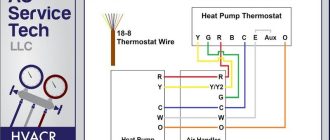
When and How to Restart Your Goodman Furnace Safely
If you’re wondering how to restart your furnace safely, you’re in the right place. Knowing when and how to restart your Goodman furnace is crucial to ensuring its proper functioning and avoiding any potential safety hazards. Whether you’ve just experienced a power outage or you simply want to perform routine maintenance, this guide will provide you with valuable tips and instructions.
When Should You Restart Your Furnace?
There are several instances when it may be necessary to restart your Goodman furnace. One common scenario is after a power outage. When the power is restored, your furnace may not automatically turn back on. In this case, you will need to restart it manually.
Another situation that may call for a furnace restart is if your unit has been idle for an extended period, such as during the summer months when you don’t need heating. Restarting your furnace before the colder months arrive can help ensure it’s in proper working condition when you need it most.
How to Safely Restart Your Furnace
Before attempting to restart your Goodman furnace, it’s essential to follow some safety precautions. Firstly, make sure the thermostat is set to the “Off” position. This will prevent any accidental activation of the furnace while you’re working on it. Secondly, switch off the furnace’s power supply by turning off the breaker in your home’s electrical panel. Finally, wait at least five minutes to allow any residual power to dissipate.
Once you’ve taken these safety measures, you can proceed to restart your furnace. Start by toggling the furnace’s power switch back on. Then, set the thermostat to the desired temperature and switch it to the “Heat” mode. Once you’ve done this, your Goodman furnace should start up and begin heating your home.
By following these guidelines, you can safely and effectively restart your Goodman furnace whenever necessary. Regular furnace maintenance and timely restarts will help keep your home warm and cozy throughout the winter months while also extending the lifespan of your unit.
Importance of Regular Furnace Maintenance
Regular furnace maintenance is crucial for ensuring the safe and efficient operation of your heating system. By properly maintaining your furnace, you can avoid costly repairs and prolong its lifespan. Here are a few reasons why regular furnace maintenance is important:
1. Energy Efficiency: Regular maintenance helps improve the energy efficiency of your furnace. Over time, dust and debris can accumulate in the system, causing it to work harder and consume more energy. By cleaning and inspecting your furnace regularly, you can ensure that it operates at peak efficiency, reducing your energy bills.
2. Safety: Furnace maintenance is essential for ensuring the safety of your home and family. A poorly maintained furnace can develop issues such as gas leaks or carbon monoxide leaks, which can be extremely dangerous. Regular inspections can detect and fix any potential safety hazards, keeping your home and loved ones safe.
3. Prevention of Costly Repairs: Regular maintenance can help identify small issues with your furnace before they turn into major problems. By addressing these issues early on, you can save yourself from expensive repairs or even the need for a full furnace replacement.
4. Improved Air Quality: Furnace maintenance includes cleaning or replacing the filters, which improves the air quality in your home. Clean filters prevent dust, pollen, and other allergens from circulating in the air, reducing the risk of respiratory issues and allergies.
5. Prolonged Lifespan: A well-maintained furnace can last longer than a neglected one. By scheduling regular maintenance, you can extend the lifespan of your furnace and get the most out of your investment.
In conclusion, regular furnace maintenance is essential for maintaining the efficiency, safety, and longevity of your heating system. By following the proper maintenance procedures and addressing any issues promptly, you can enjoy a warm and comfortable home throughout the winter season.
Signs That Your Goodman Furnace Needs Restarting
If your Goodman furnace is not working properly, it may be time to restart it. Here are some signs that indicate your furnace needs to be restarted:
No Heat: If you notice that your furnace is not producing any heat, it could be a sign that it needs to be restarted. This could be due to a variety of reasons, such as a malfunctioning thermostat or a clogged air filter.
Strange Noises: Unusual noises coming from your furnace, such as banging, rattling, or grinding sounds, may indicate that it needs to be restarted. These noises could be caused by loose components or a faulty motor.
Frequent Cycling: If your furnace constantly turns on and off without reaching the desired temperature, it may be time to restart it. This could be a result of a malfunctioning flame sensor or a blocked airflow.
Pilot Light Failure: If the pilot light on your Goodman furnace goes out, you will need to restart it. This could be caused by a draft or a faulty thermocouple.
Error Codes: Modern Goodman furnaces are equipped with error codes that indicate specific problems. If you see an error code on your furnace’s display, consult the manufacturer’s manual to determine if a restart is necessary.
Remember, restarting your furnace should only be done if you feel comfortable and confident in doing so. If you are unsure, it is best to contact a professional HVAC technician to avoid any potential hazards or further damage to your furnace.
Understanding the Safety Precautions
Restarting a furnace requires careful attention to safety precautions to ensure the well-being of both the homeowner and the equipment. Here are some important safety measures to follow when restarting a furnace:
1. Turn off the power: Before attempting to restart the furnace, make sure to turn off the power supply to prevent any electrical hazards. Locate the main power switch and switch it off.
2. Check for gas leaks: Gas leaks can be extremely dangerous, so it’s crucial to inspect for any signs of a leak before restarting the furnace. Use a gas leak detector or soapy water to check the gas lines and connections. If you smell gas or notice any bubbles forming when applying the soapy water solution, immediately shut off the gas supply and contact a professional technician.
3. Clear the area: Before restarting the furnace, ensure that the surrounding area is clear of any flammable materials, such as paper, cardboard, or cleaning products. This will prevent the risk of fire or explosion.
4. Follow manufacturer instructions: Each furnace model has specific instructions for restarting, so it’s important to consult the manufacturer’s manual. These instructions will guide you through the process step-by-step, ensuring that you don’t miss any important safety measures.
5. Wear protective gear: When working with a furnace, it’s recommended to wear protective gear, such as gloves and safety glasses, to protect yourself from any potential hazards.
By following these safety precautions, you can safely restart your furnace and ensure the efficient and reliable operation of your Goodman furnace.
How to Determine If It’s Safe to Restart Your Goodman Furnace
Before attempting to restart your Goodman furnace, it’s important to ensure the safety of the process. Here are some steps to help you determine if it’s safe to restart your furnace:
- Check for gas leaks: Before restarting your furnace, check for any gas leaks. You can do this by smelling for gas or using a gas leak detector. If you detect any gas leaks, turn off the gas supply immediately and contact a professional for assistance.
- Inspect the furnace for damages: Ensure that there are no visible damages to the furnace, such as cracks or leaks. Damages can be dangerous and may cause further issues if not addressed. If you notice any damages, it’s best to contact a professional to inspect and repair the furnace.
- Check the thermostat: Make sure the thermostat is set to a low temperature, ensuring that the furnace doesn’t start up immediately when restarting. This will prevent any potential safety hazards.
- Clear the area around the furnace: Remove any flammable objects or debris from the vicinity of the furnace. This will reduce the risk of fires or accidents during the restart process.
- Check the electrical connections: Ensure that all electrical connections are secure and undamaged. Loose or damaged connections can cause electrical issues and pose a safety risk. If you notice any problems, it’s advisable to contact a professional electrician for assistance.
- Inspect the air filters: Check the air filters to ensure they are clean and free from any debris. Clogged or dirty filters can restrict airflow and reduce the efficiency of the furnace. Replace the filters if necessary.
- Test the carbon monoxide detector: Make sure your carbon monoxide detector is in proper working condition. This is crucial for the safety of your household, as a malfunctioning furnace can produce carbon monoxide gas, which is highly dangerous. Replace the batteries if needed.
Following these steps will help you determine if it’s safe to restart your Goodman furnace. Remember, if you have any doubts or concerns, it’s always best to seek professional assistance to ensure the safety of your furnace and your home.
Steps for Restarting Your Goodman Furnace
To safely restart your Goodman furnace, follow these steps:
- Check the thermostat: Make sure the thermostat is set to the desired temperature and is in the “heat” mode.
- Turn off the power: Locate the furnace switch or circuit breaker and make sure it is in the “off” position.
- Check for gas leaks: If you have a gas furnace, use a gas leak detector or a solution of soapy water to check for any gas leaks around the furnace and gas connections. If you detect a gas leak, leave the area immediately and contact a professional.
- Inspect the air filter: Check the air filter and replace it if necessary. A dirty or clogged air filter can hinder proper furnace operation.
- Turn on the power: Once you have checked for gas leaks and inspected the air filter, you can turn the furnace switch or circuit breaker back to the “on” position.
- Reset the furnace: Locate the reset button on your furnace’s control panel and press it. This will reset the furnace and clear any error codes.
- Wait for the furnace to start: It may take a few minutes for the furnace to start up after you have reset it. Listen for the sound of the burners igniting and the blower fan starting.
- Monitor the furnace: Once the furnace is running, pay attention to any unusual noises or smells. If you notice anything out of the ordinary, turn off the furnace and contact a professional.
- Check for proper heating: Verify that warm air is coming out of the vents in each room. If the air is not warm or the airflow is weak, there may be an issue with the furnace that requires professional attention.
Following these steps will help you safely restart your Goodman furnace and ensure it is operating properly.
Ensuring Proper Ventilation
Proper ventilation is essential for the safe operation of your Goodman furnace. Before restarting your furnace, you should ensure that there is adequate ventilation in the area where your furnace is located.
First and foremost, check that all vents and air intake grilles are clear of any obstructions. Remove any debris or objects that may be blocking the airflow. This will allow for proper circulation of air and prevent the furnace from overheating.
In addition to checking the vents and air intake grilles, you should also inspect the flue pipe. The flue pipe is responsible for removing the exhaust gases from the furnace. Make sure that the flue pipe is free of debris and that there are no leaks or damage. It is important to have a properly functioning flue pipe to prevent carbon monoxide buildup.
If you are unsure about the condition of your flue pipe or if you suspect any damage, it is recommended to contact a professional HVAC technician for inspection and repair.
Finally, make sure that there is adequate fresh air intake in the room where your furnace is located. Furnaces require a constant supply of air for combustion. Insufficient airflow can result in improper operation and potential safety hazards.
By ensuring proper ventilation, you can safely restart your furnace and enjoy its efficient heating capabilities. Remember to regularly check and maintain the ventilation system to ensure the continued safe operation of your Goodman furnace.
Checking the Thermostat Settings
Before restarting your furnace, it’s important to check the thermostat settings to ensure they are properly configured. Here’s how to do it:
- Make sure the thermostat is set to “Heat” mode. If it’s set to “Cool” or “Off”, the furnace will not turn on.
- Check the temperature setting. If the thermostat is set to a temperature that is lower than the current room temperature, the furnace may not turn on.
- Ensure that the thermostat’s batteries, if applicable, are fresh and installed correctly. Weak or dead batteries can cause the thermostat to malfunction.
- Check the fan setting on the thermostat. If it’s set to “Auto”, the furnace will only turn on when heating is required. If it’s set to “On”, the fan will run continuously, regardless of whether the furnace is operating.
- If you have a programmable thermostat, verify that the schedule is set correctly for the desired heating periods.
By double-checking these thermostat settings, you can ensure that your furnace is ready to be restarted and that it will provide the desired heating for your home.
Clearing the Air Filters
One important step in safely restarting your Goodman furnace is to clear the air filters. Over time, air filters can become clogged with dirt, dust, and other debris, restricting airflow and reducing the efficiency of your furnace. Clearing the air filters can help improve the performance of your furnace and prevent potential issues.
To clear the air filters of your Goodman furnace, follow these steps:
| 1. | Locate the air filter compartment on your furnace. This is usually located near the air intake or blower compartment. |
| 2. | Turn off the power to your furnace. You can do this by switching off the circuit breaker or turning off the main power switch. |
| 3. | Open the air filter compartment and carefully remove the old air filter. |
| 4. | Inspect the old air filter for any signs of damage or excessive dirt buildup. If the filter is damaged or extremely dirty, it is recommended to replace it with a new one. |
| 5. | If the old air filter is still in good condition, use a vacuum cleaner or a brush to remove any dust or debris from the filter. You can also rinse the filter with water if it is washable. |
| 6. | Allow the air filter to fully dry before reinstalling it into the furnace. |
| 7. | Insert the cleaned or new air filter back into the air filter compartment, making sure it is securely in place. |
| 8. | Close the air filter compartment and ensure it is properly sealed. |
| 9. | Turn the power back on to your furnace by switching on the circuit breaker or the main power switch. |
| 10. | You have now successfully cleared the air filters of your Goodman furnace, ensuring proper airflow and efficient operation. |
Inspecting the Ignition System
When it comes to restarting your furnace, one of the most important components to inspect is the ignition system. The ignition system is responsible for igniting the fuel in your furnace to heat your home. If there are any issues with the ignition system, your furnace may not be able to start or may not produce heat properly.
Here are steps on how to inspect the ignition system:
| 1. | Start by turning off the power to your furnace. This is important to ensure your safety while inspecting the ignition system. |
| 2. | Next, locate the ignition control module. This is usually a small box located near the burner assembly of your furnace. Remove the cover of the ignition control module to access the components inside. |
| 3. | Inspect the ignition control module for any signs of damage or wear. Look for burnt wires, loose connections, or any other visible issues. If you notice any problems, it may be necessary to replace the ignition control module. |
| 4. | Check the ignition electrodes for any build-up or corrosion. Clean the electrodes using a soft brush or sandpaper if necessary. Clean igniter electrodes can help ensure a proper ignition of the fuel. |
| 5. | Inspect the flame sensor if your furnace has one. The flame sensor is responsible for detecting the presence of a flame. Clean the flame sensor with a soft cloth or fine-grit sandpaper to remove any dirt or debris that may be interfering with its operation. |
| 6. | Once you have inspected and cleaned the ignition system components, reassemble the ignition control module and replace the cover. Make sure all connections are secure. |
| 7. | Finally, turn the power back on to your furnace and test the ignition system by starting the furnace. If everything has been properly inspected and cleaned, your furnace should start up without any issues. |
Inspecting and maintaining the ignition system of your furnace is crucial for ensuring its efficient operation. If you are unsure or uncomfortable inspecting the ignition system yourself, it is always recommended to hire a professional HVAC technician to do this task for you.
Checking for Gas Leaks
Before restarting your furnace, it’s important to ensure that there are no gas leaks present. Follow these steps to check for gas leaks:
- Turn off the gas supply valve: Locate the gas supply valve, typically located near the furnace, and ensure it is in the “off” position.
- Inspect for any visible damage: Visually inspect the gas line and connections for any signs of damage or corrosion. If you notice any, it’s important to call a professional to repair it before proceeding.
- Use a gas leak detector: If you have a gas leak detector, carefully follow the manufacturer’s instructions to check for any gas leaks around the furnace area. These detectors are designed to detect even small amounts of gas in the air.
- Check for the smell of gas: While natural gas is odorless, an added odorant called mercaptan is added, giving it a distinct smell similar to rotten eggs. If you smell gas, it’s an indication of a gas leak, and you should leave the area immediately and contact your gas supplier.
- Open windows and doors: If you don’t have a gas leak detector, it’s a good idea to open windows and doors in the area to allow for proper ventilation and to help dissipate any potential gas buildup.
Remember, only attempt to restart your furnace if you are confident that there are no gas leaks present. If you have any doubts or concerns regarding gas leaks, it’s always best to contact a professional HVAC technician to assess the situation and make any necessary repairs.
Observing the Flame Color and Shape
One important aspect of restarting a furnace safely is to observe the flame color and shape.
When you first start your Goodman furnace, the flame should have a blue color and a steady, cone-shaped appearance. This indicates that the fuel is burning efficiently and evenly. A steady flame also indicates that the furnace is receiving the correct amount of air for combustion.
If you notice any abnormalities in the flame color or shape, it may indicate a problem with your furnace. For example, if the flame is yellow or orange, it could indicate incomplete combustion, which can cause the release of harmful carbon monoxide gas. If the flame is flickering or dancing around, it may suggest problems with the air flow or a blocked vent.
If you observe any of these issues with the flame color or shape, it is important to turn off your furnace immediately and contact a professional technician for inspection and repairs. Attempting to restart the furnace in these conditions can be dangerous and may lead to further damage or safety hazards.
Regularly observing the flame color and shape when restarting your furnace can help ensure that it is running safely and efficiently. If you notice any changes or abnormalities, it is always best to err on the side of caution and seek professional assistance.
Verifying Proper Functioning of Safety Devices
When restarting your furnace, it is important to ensure that all safety devices are functioning properly. These safety devices are designed to protect your home and family from potential hazards. Here is how to verify their proper functioning:
1. Check the power supply: Ensure that your furnace is connected to a power source and that the circuit breaker or fuse is not tripped or blown. A malfunctioning power supply can prevent safety devices from working correctly.
2. Test the limit switch: The limit switch is a safety device that shuts off the furnace if it detects overheating. To test the limit switch, set your thermostat to a high temperature and wait for the furnace to start. Once the furnace starts, monitor the temperature for a few minutes. If the temperature exceeds the limit set by the switch, the furnace should shut off automatically. This indicates that the limit switch is functioning properly.
3. Inspect the flame rollout switch: The flame rollout switch is designed to shut off the furnace if it detects flames outside of the combustion area. Locate the flame rollout switch and ensure that it is not tripped or blocked. If the switch is tripped, carefully reset it according to the manufacturer’s instructions. If the switch continues to trip, contact a professional technician to inspect and repair the furnace.
4. Test the pressure switch: The pressure switch ensures that proper airflow is maintained in the furnace. To test the pressure switch, start the furnace and listen for the sound of the draft inducer fan. If the fan starts and continues running, it indicates that the pressure switch is functioning properly. If the fan does not start or stops running, there may be an issue with the pressure switch that requires professional attention.
5. Check the flame sensor: The flame sensor is responsible for detecting the presence of a flame and ensuring its proper ignition. Locate the flame sensor and clean it with a soft cloth if it appears dirty or covered in soot. A dirty flame sensor can prevent the furnace from staying lit. If cleaning the flame sensor does not solve the issue, contact a professional technician to inspect and replace the sensor if necessary.
By following these steps, you can ensure that all safety devices in your furnace are functioning properly before restarting it. It is always recommended to consult the manufacturer’s manual or seek professional assistance if you are unsure about any maintenance or troubleshooting procedures.
Properly Resetting the Controls
In order to safely restart your Goodman furnace, it is important to properly reset the controls. This process is relatively simple and can be done by following the steps below:
- Locate the power switch on your furnace and make sure it is in the “Off” position. This will ensure that the furnace is completely powered down.
- Wait for at least five minutes to allow the furnace to fully cool down before proceeding with the reset.
- Once the furnace has cooled down, locate the control panel on the furnace. This panel is usually located on the front of the unit and can be removed by using a screwdriver or other tool.
- Find the reset button on the control panel. Press and hold this button for about five seconds, or until you hear a click. This will reset the furnace’s controls and prepare it for restart.
- Replace the control panel cover and ensure it is securely fastened.
- Finally, locate the power switch again and flip it to the “On” position. This will restore power to the furnace.
By following these simple steps, you can safely reset the controls on your Goodman furnace and ensure that it starts up properly. If you continue to experience issues with your furnace after resetting the controls, it may be necessary to contact a qualified HVAC technician for further assistance.
Cleaning and Lubricating the Furnace Components
As part of regular furnace maintenance, it’s important to clean and lubricate the various components in order to ensure optimal performance. Here’s how to restart a furnace and clean and lubricate its components:
1. Turn off the power to the furnace by switching off the circuit breaker that supplies electricity to it.
2. Remove the furnace door by unscrewing the holding screws or releasing the latches.
3. Locate the blower assembly, which consists of a motor, fan, and housing. Use a brush or a vacuum cleaner to remove any accumulated dust and debris.
4. Check the motor and fan for any signs of wear or damage. If necessary, lubricate the motor’s oil ports with a few drops of lightweight non-detergent motor oil.
5. Inspect the belts that connect the motor to the blower assembly. If they appear cracked or worn, replace them with new ones.
6. Clean or replace the furnace filter, which helps to remove dust and allergens from the air. A clogged filter can restrict airflow and reduce furnace efficiency.
7. Clean the burners and the flame sensor. Use a brush or a soft cloth to gently remove any dirt or debris.
8. Check the pilot light or ignition system. If the pilot light is out, follow the manufacturer’s instructions for relighting it. If using an electronic ignition system, ensure that it is functioning properly.
9. Put the furnace door back on and secure it with the holding screws or latches.
10. Turn on the power to the furnace by switching on the circuit breaker.
By regularly cleaning and lubricating your furnace components, you can improve its efficiency and extend its lifespan. If you are unsure about any steps or encounter any issues, it is recommended to consult a professional HVAC technician.
Scheduling Professional Furnace Maintenance
Regular maintenance is essential to ensure the proper functioning and longevity of your Goodman furnace. While there are some tasks you can perform on your own, such as changing the air filter, scheduling professional furnace maintenance is highly recommended. Here’s why:
- Expertise: HVAC technicians have the knowledge and experience to identify and address any potential issues with your furnace. They can perform a thorough inspection, clean the components, and make necessary adjustments to ensure optimal performance.
- Safety: Furnaces involve complex systems that can be dangerous if not handled properly. Professional technicians are trained in handling potentially hazardous situations and can ensure that your furnace is operating safely.
- Efficiency: Regular maintenance can optimize your furnace’s efficiency, which can lead to energy savings and lower utility bills. Technicians can inspect and clean the burners, adjust the gas pressure, and check for any leaks, ensuring that your furnace operates at peak efficiency.
- Warranty: Many furnace manufacturers require regular professional maintenance to keep the warranty valid. By scheduling regular maintenance, you can ensure that your furnace remains under warranty and avoid any unexpected costs for repairs.
How often should you schedule professional furnace maintenance?
It is generally recommended to schedule professional furnace maintenance once a year. The ideal time for maintenance is during the fall, before the heating season begins. This allows the technician to address any potential issues and ensure that your furnace is ready to provide reliable and efficient heat throughout the winter.
By scheduling professional furnace maintenance, you can rest assured that your Goodman furnace is in good hands and will continue to provide reliable heat for years to come. Contact your local HVAC company to schedule an appointment today!
Q&A:
How often should I restart my Goodman furnace?
It is generally recommended to restart your furnace at least once a year, preferably before the start of the heating season. This can help ensure that the furnace is functioning properly and can help prevent any potential issues.
What are some signs that my Goodman furnace needs to be restarted?
If your furnace is not producing heat, is making unusual noises, or is not turning on at all, it may be a sign that it needs to be restarted. Additionally, if you notice a burning smell or if your furnace is frequently cycling on and off, these can also be indicators that a restart is necessary.
What is the proper way to restart a Goodman furnace?
To restart a Goodman furnace, first ensure that the thermostat is set to the “off” position. Then, locate the furnace’s power switch, which is typically located on or near the furnace itself. Flip the switch to the “off” position and wait at least 10 seconds. After this, flip the switch back to the “on” position and set the thermostat to the desired temperature. The furnace should then start up and begin producing heat.
Are there any safety precautions to take when restarting a Goodman furnace?
Yes, there are several safety precautions to keep in mind when restarting a Goodman furnace. First, be sure to turn off the power to the furnace before beginning any work. This can help prevent electrical shock. Additionally, be cautious of any gas or fuel leaks, as these can be hazardous. If you smell gas or suspect a leak, leave the area immediately and contact a professional for assistance. It is also important to regularly inspect and replace the furnace’s air filters to ensure proper airflow and prevent any potential issues.




